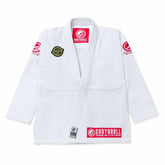BJJ Competitor vs Hobbyist: What's the Real Difference?
Brazilian Jiu Jitsu (BJJ) is a martial art. It attracts a diverse range of practitioners—from casual hobbyists to elite competitors chasing gold medals. While they often share the same mats, train under the same instructors and wear the same BJJ Gi, the mindset, lifestyle and goals of a BJJ competitor versus a BJJ hobbyist can differ significantly. It does not matter whether you are new to Brazilian Jiu Jitsu or deep into the sport. Understanding this distinction can help clarify your own path and optimize your training journey.
What is a BJJ Hobbyist?
A BJJ hobbyist is someone who trains Brazilian Jiu Jitsu primarily for fun, fitness, self-defense and personal development. Most hobbyists are not driven by competition goals. Instead, they find joy in the art of grappling, the physical challenge and the camaraderie of the gym.
Key Traits of a BJJ Hobbyist:
- Frequency of Training: 2–4 times per week
- Motivation: Stress relief, fitness, social interaction, and self-improvement
- Commitment Level: Moderate; BJJ is a part of life, but not the center
- Gear Choice: Standard Gi and No-Gi apparel; emphasis on comfort
- Progression: Typically slower, but steady over the years
Hobbyists form the backbone of every BJJ academy. They are the ones who show up consistently, support seminars, roll with respect and often maintain balance with family, work and other life priorities.
Who is a BJJ Competitor?
A BJJ competitor is someone who actively trains to compete in tournaments—whether local opens, IBJJF events, or even world championships. For competitors, Brazilian Jiu Jitsu is not just a martial art; it is a lifestyle.
Key Traits of a BJJ Competitor:
- Training Intensity: 5–7 sessions per week, often including double sessions
- Motivation: Winning medals, gaining recognition, possibly earning sponsorships
- Commitment Level: High; training, dieting, and recovery are structured around BJJ
- Gear Choice: Competition-legal BJJ Gis (especially IBJJF approved BJJ GI)
- Progression: Often faster, driven by high-level coaching and consistent pressure
Competitors are the faces you see on podiums, on Instagram clips executing perfect submissions and often the reason your gym is buzzing with energy during tournament season.
Training Approach: Hobbyist vs Competitor
The core difference in their training approach lies in intensity and intent.
BJJ Hobbyist:
- Tends to roll in a more playful, relaxed manner.
- Focuses on learning rather than winning every round.
- Prioritizes injury prevention and long-term consistency.
- May skip tough sparring or sit out when fatigued.
BJJ Competitor:
- Pushes the pace in every round, even in training.
- Drills specific techniques repetitively for mastery.
- Seeks high-level rolls to sharpen skills.
- Trains through minor injuries and fatigue.
This does not mean hobbyists don’t work hard. It just means competitors operate with a different mental gear tuned for competition scenarios.
Lifestyle Differences: On and Off the Mat
Off the mat, the contrast becomes even clearer.
Nutrition and Recovery
- Competitors often follow strict meal plans, manage weight cuts and use supplements for recovery.
- Hobbyists usually eat for general health and enjoyment, without obsessing over macros or cutting weight.
Daily Schedule
- Competitors might train twice a day, schedule strength and conditioning, attend mobility sessions and get regular physiotherapy.
- Hobbyists fit BJJ around work, family and other commitments, often training in the evenings or weekends.
Mindset
- Competitors are mentally focused on progress, competition strategy and performance metrics.
- Hobbyists are usually more focused on fun, community and personal milestones like earning stripes or a new BJJ belt.
Which is Better? Competitor or Hobbyist?
The answer depends entirely on your goals. There is no right or wrong path in Brazilian Jiu Jitsu.
- If you love to test yourself under pressure and thrive on competition, then being a BJJ competitor may be the route for you.
- If you want BJJ to enhance your life, not consume it, then enjoying it as a hobbyist will serve you better in the long run.
The beauty of BJJ is that both competitors and hobbyists share the same mats. One does not need to dominate or dismiss the other. In fact, many hobbyists inspire competitors with their passion and many competitors motivate hobbyists with their discipline.
Transitioning Between Roles
Life circumstances change. You may start as a hobbyist and feel the itch to compete. Or, you may be a seasoned competitor looking to slow down due to injury or personal priorities.
- Brazilian Jiu Jitsu allows for fluid transitions. Your journey can evolve:
- Compete at white or blue belt and return to hobbyist mode.
- Take time off, then ramp up for a new season.
- Shift from competing to coaching and mentoring others.
This flexibility is one of the reasons why BJJ has become so popular across all age groups and walks of life.
Final Thoughts
Whether you wear a BJJ Gi five times a week to prepare for tournaments or twice a week for the love of the sport, your contribution to the Brazilian Jiu Jitsu community matters. The real difference between a BJJ competitor and a hobbyist is not just in skill or strength. But it is in intention.
- One trains to win.
- The other trains to grow.
But both step on the mat to become better versions of themselves.
If you are starting your BJJ journey or thinking about switching roles, ask yourself: What do I want from this martial art? The answer will guide your training, your schedule and your satisfaction in the long run.







